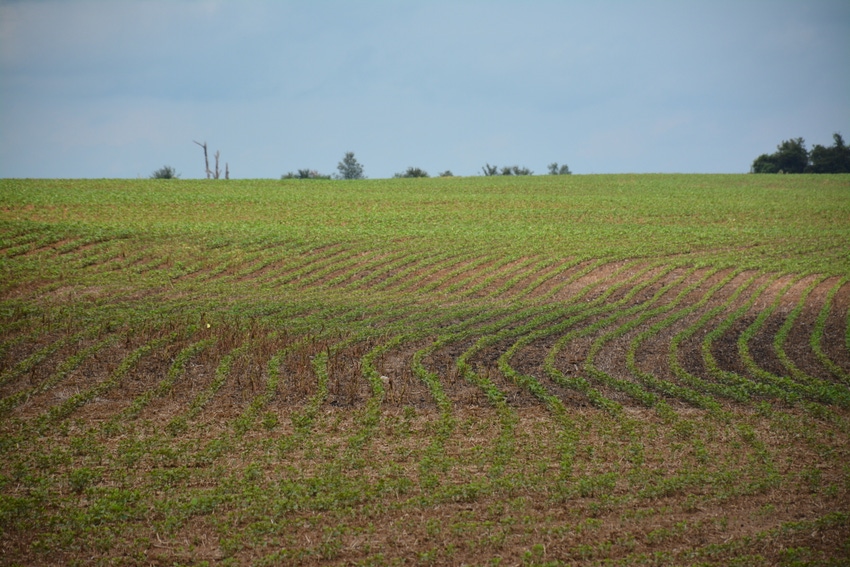July 11, 2016

As if farmers needed more reasons for planting winter cover crops, University of Tennessee researchers have found another one – they appear to significantly reduce the amount of nutrients moving from their fields to nearby streams.
Using what is known as a Soil and Water Assessment Tool, scientists with the University of Tennessee Institute of Agriculture have modeled what would happen if Tennessee soybean and corn farmers incorporated an unfertilized winter wheat cover crop into their annual crop rotations.
Shawn Hawkins, an associate professor in the Biosystems Engineering and Soil Science Department, and Hannah McClellan, a research associate working with Hawkins, used a SWAT water quality model to evaluate the nutrient load reduction for winter wheat cover crops on corn and soybean fields in both the Red River and South Fork of the Obion River watersheds in Tennessee.
SWAT, a simulation model that links hydrology and nutrient cycling with crop growth, is a public domain model developed by USDA’s Agricultural Research Service specifically to predict the environmental impact of land use and land management practices in rural agricultural watersheds.
Hawkins and McClellan introduced elevation data, crop satellite imagery and soils data into the SWAT model and included Tennessee rainfall inputs to calibrate the model with measured river flow rates.
Crop management schedules (such as planting, fertilizer applications and harvesting) were established in consultation with corn and soybean producers and included modifications of three important soil parameters resulting from the current adoption of contour and no-till planting, farming practices that have already substantially reduced nutrient losses from agricultural fields in Tennessee.
Model prediction
Their model predicts that incorporation of an unfertilized winter wheat cover crop on all of the row crop fields in the Red River and South Fork of the Obion River watersheds would result in substantial upland loss reductions of total nitrogen (30-50 percent) and total phosphorus (12-32 percent).
The model results indicate farmers using this strategy can significantly reduce the amount of nitrogen and total phosphorus lost from row crop fields enhancing downstream water quality, including as far away as the Gulf of Mexico.
The strategy has the potential to significantly reduce the Tennessee portion of the Mississippi River nutrient load that contributes to a dead zone in the northern Gulf of Mexico. An expanse of the Gulf of Mexico near the mouth of the Mississippi River is known as the dead zone because annual blooms of algae and phytoplankton deplete the water of most of its oxygen, a condition known as hypoxia.
Efforts are underway in many states within the Mississippi River basin to reduce crop nutrient loss, and the results of Hawkins and McClellan’s study may have implications for other states working to meet hypoxia nutrient reduction goals established by the EPA to remediate the Northern Gulf Dead Zone.
Their study is part of a larger effort known as the Tennessee Nutrient Reduction Framework, which was developed to satisfy the water quality needs of Tennessee’s streams and rivers, while also benefiting downstream water users and assisting in the federal goals for the Gulf of Mexico.
Erosion prevention
“I believe this is a method of first choice for our row crop producers to help reduce nutrient loss from the row crop fields within our state,” said Hawkins. “And it carries the added benefit of additional field erosion protection that complements nicely with no-till crop production.”
Hawkins and McClellan will discuss their findings with farmers at the UT Institute of Agriculture’s Milan No-Till Field Day scheduled for July 28 at UT’s AgResearch and Education Center in Milan.
Billed as the nation’s largest no-till field day, researchers from Tennessee and other regional institutions present to farmers the latest management techniques to keep their farms profitable and sustainable through no-till and minimum tillage that “saves the soil” by sparing the plow.
The work was funded by the Tennessee Department of Environment and Conservation and was presented at the 25th Tennessee Water Resources Symposium in April (proceedings online at: http://tnawra.er.usgs.gov/Library/Proceedings2016.pdf.)
Through its mission of research, teaching and extension, the University of Tennessee Institute of Agriculture touches lives and provides Real. Life. Solutions. ag.tennessee.edu
About the Author(s)
You May Also Like






